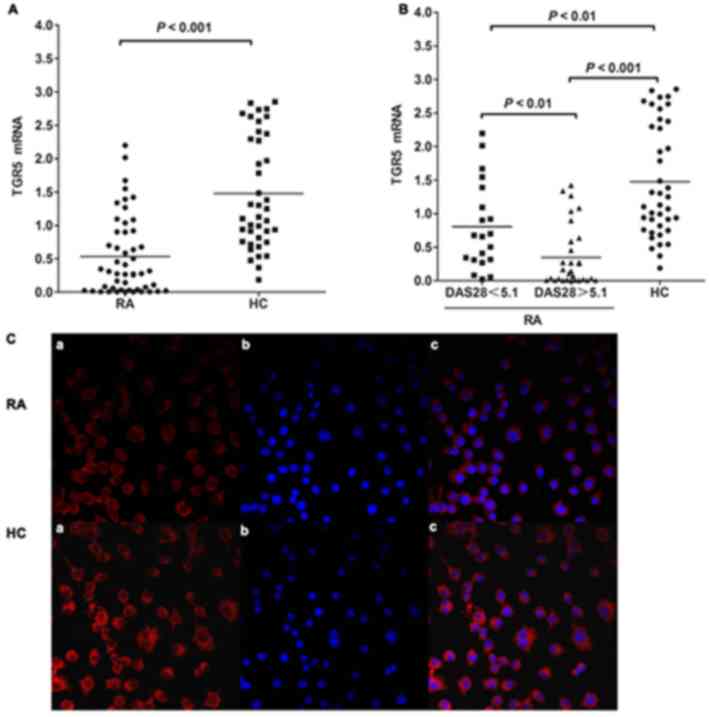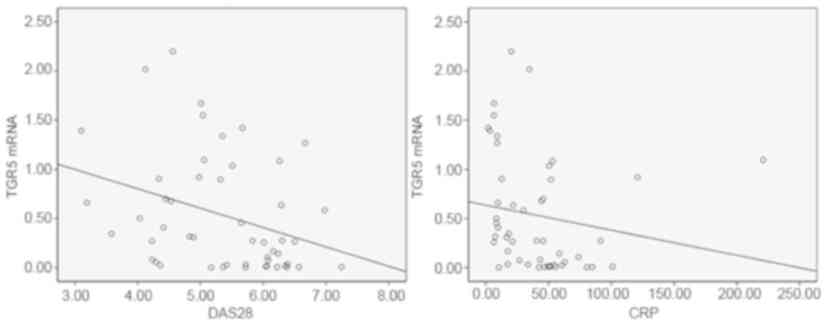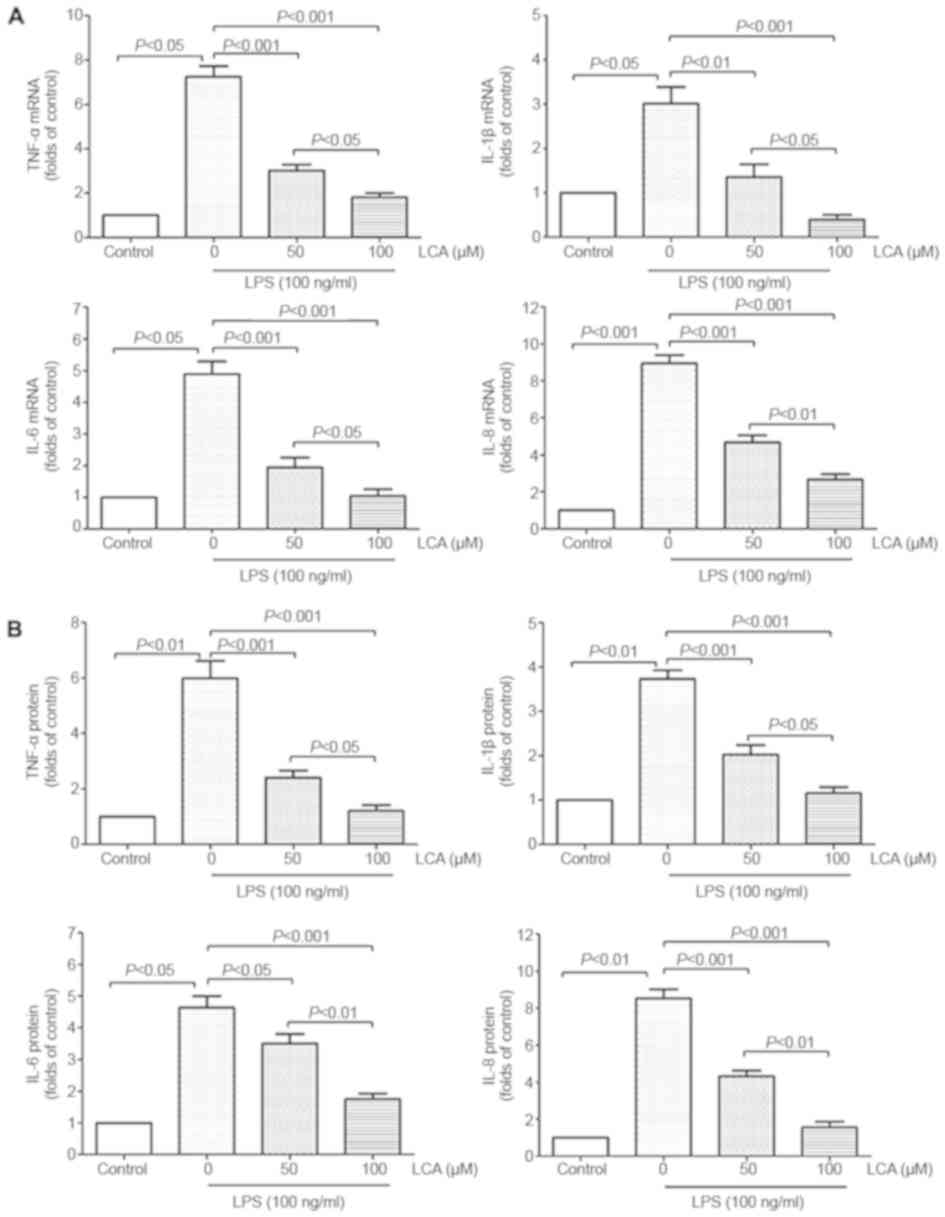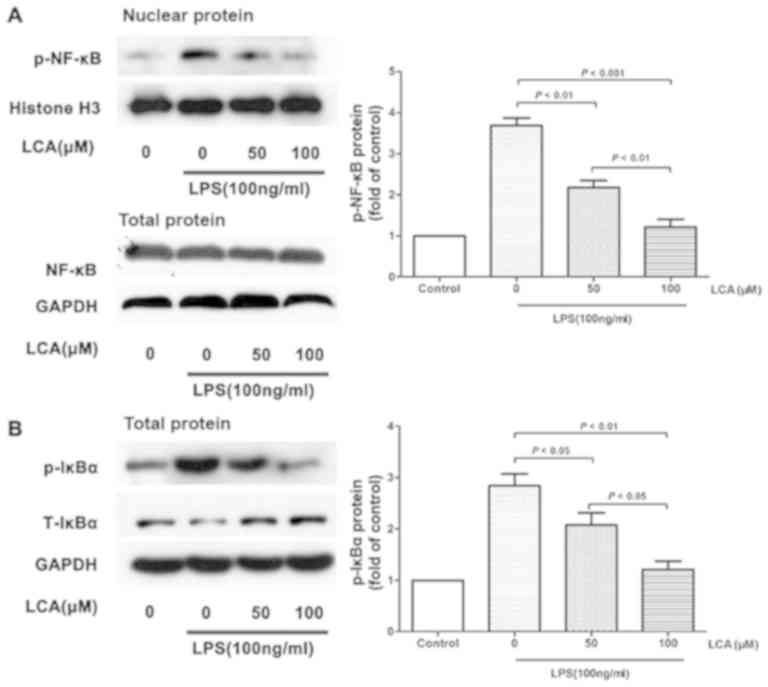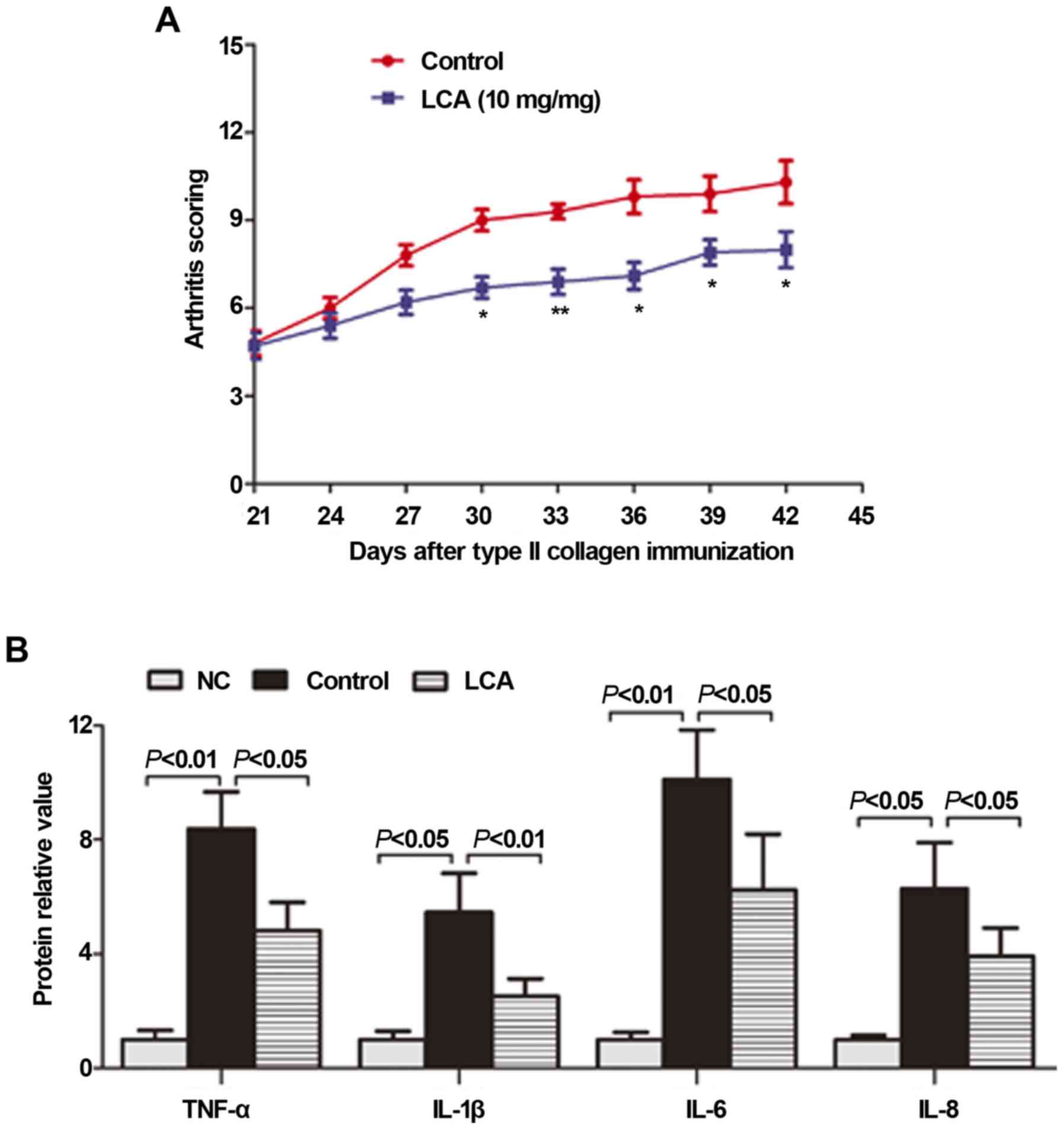|
1
|
Siebert S, Tsoukas A, Robertson J and
McInnes I: Cytokines as therapeutic targets in rheumatoid arthritis
and other inflammatory diseases. Pharmacol Rev. 67:280–309. 2015.
View Article : Google Scholar : PubMed/NCBI
|
|
2
|
Choy EH and Panayi GS: Cytokine pathways
and joint inflammation in rheumatoid arthritis. N Engl J Med.
344:907–916. 2001. View Article : Google Scholar : PubMed/NCBI
|
|
3
|
Karsdal MA, Woodworth T, Henriksen K,
Maksymowych WP, Genant H, Vergnaud P, Christiansen C, Schubert T,
Qvist P, Schett G, et al: Biochemical markers of ongoing joint
damage in rheumatoid arthritis-current and future applications,
limitations and opportunities. Arthritis Res Ther. 13:2152011.
View Article : Google Scholar : PubMed/NCBI
|
|
4
|
Wang Q, Ma Y, Liu D, Zhang L and Wei W:
The roles of B cells and their interactions with fibroblast-like
synoviocytes in the pathogenesis of rheumatoid arthritis. Int Arch
Allergy Immunol. 155:205–211. 2011. View Article : Google Scholar : PubMed/NCBI
|
|
5
|
Lefevre S, Meier FM, Neumann E and
Muller-Ladner U: Role of synovial fibroblasts in rheumatoid
arthritis. Curr Pharm Des. 21:130–141. 2015. View Article : Google Scholar : PubMed/NCBI
|
|
6
|
Roberts CA, Dickinson AK and Taams LS: The
interplay between monocytes/macrophages and CD4(+) T cell subsets
in rheumatoid arthritis. Front Immunol. 6:5712015. View Article : Google Scholar : PubMed/NCBI
|
|
7
|
Davignon JL, Hayder M, Baron M, Boyer JF,
Constantin A, Apparailly F, Poupot R and Cantagrel A: Targeting
monocytes/macrophages in the treatment of rheumatoid arthritis.
Rheumatology (Oxford). 52:590–598. 2013. View Article : Google Scholar : PubMed/NCBI
|
|
8
|
Kinne RW, Stuhlmuller B and Burmester GR:
Cells of the synovium in rheumatoid arthritis. Macrophages.
Arthritis Res Ther. 9:2242007. View
Article : Google Scholar : PubMed/NCBI
|
|
9
|
Schett G: Cells of the synovium in
rheumatoid arthritis. Osteoclasts. Arthritis Res Ther. 9:2032007.
View Article : Google Scholar : PubMed/NCBI
|
|
10
|
Yokota K: Inflammation and osteoclasts.
Nihon Rinsho Men'eki Gakkai kaishi. 40:367–376. 2017.(In Japanese).
View Article : Google Scholar
|
|
11
|
Alam J, Jantan I and Bukhari SNA:
Rheumatoid arthritis: Recent advances on its etiology, role of
cytokines and pharmacotherapy. Biomed Pharmacother. 92:615–633.
2017. View Article : Google Scholar : PubMed/NCBI
|
|
12
|
Mulherin D, Fitzgerald O and Bresnihan B:
Synovial tissue macrophage populations and articular damage in
rheumatoid arthritis. Arthritis Rheum. 39:115–124. 1996. View Article : Google Scholar : PubMed/NCBI
|
|
13
|
Yanni G, Whelan A, Feighery C and
Bresnihan B: Synovial tissue macrophages and joint erosion in
rheumatoid arthritis. Ann Rheum Dis. 53:39–44. 1994. View Article : Google Scholar : PubMed/NCBI
|
|
14
|
Aravilli RK, Vikram SL and Kohila V:
Phytochemicals as potential antidotes for targeting NF-κB in
rheumatoid arthritis. 3 Biotech. 7:2532017. View Article : Google Scholar : PubMed/NCBI
|
|
15
|
Roman-Blas JA and Jimenez SA: NF-κB as a
potential therapeutic target in osteoarthritis and rheumatoid
arthritis. Osteoarthritis and Cartilage. 14:839–848. 2006.
View Article : Google Scholar : PubMed/NCBI
|
|
16
|
McInnes IB and Schett G: Cytokines in the
pathogenesis of rheumatoid arthritis. Nat Rev Immunol. 7:429–442.
2007. View Article : Google Scholar : PubMed/NCBI
|
|
17
|
Schaap FG, Trauner M and Jansen PL: Bile
acid receptors as targets for drug development. Nat Rev
Gastroenterol Hepatol. 11:55–67. 2014. View Article : Google Scholar : PubMed/NCBI
|
|
18
|
Lin TH, Tang CH, Wu K, Fong YC, Yang RS
and Fu WM: 15-deoxy-Δ(12,14)-prostaglandin-J2 and ciglitazone
inhibit TNF-α-induced matrix metalloproteinase 13 production via
the antagonism of NF-κB activation in human synovial fibroblasts. J
Cell Physiol. 226:3242–3250. 2011. View Article : Google Scholar : PubMed/NCBI
|
|
19
|
Yu DD, Sousa KM, Mattern DL, Wagner J, Fu
X, Vaidehi N, Forman BM and Huang W: Stereoselective synthesis,
biological evaluation, and modeling of novel bile acid-derived
G-protein coupled bile acid receptor 1 (GP-BAR1, TGR5) agonists.
Bioorg Med Chem. 23:1613–1628. 2015. View Article : Google Scholar : PubMed/NCBI
|
|
20
|
Pols TW: TGR5 in inflammation and
cardiovascular disease. Biochem Soc Trans. 42:244–249. 2014.
View Article : Google Scholar : PubMed/NCBI
|
|
21
|
Russell DW and Setchell KD: Bile acid
biosynthesis. Biochemistry. 31:4737–4749. 1992. View Article : Google Scholar : PubMed/NCBI
|
|
22
|
Pols TW, Noriega LG, Nomura M, Auwerx J
and Schoonjans K: The bile acid membrane receptor TGR5 as an
emerging target in metabolism and inflammation. J Hepatol.
54:1263–1272. 2011. View Article : Google Scholar : PubMed/NCBI
|
|
23
|
Kawamata Y, Fujii R, Hosoya M, Harada M,
Yoshida H, Miwa M, Fukusumi S, Habata Y, Itoh T, Shintani Y, et al:
A G protein-coupled receptor responsive to bile acids. J Biol Chem.
278:9435–9440. 2003. View Article : Google Scholar : PubMed/NCBI
|
|
24
|
Keitel V, Donner M, Winandy S, Kubitz R
and Haussinger D: Expression and function of the bile acid receptor
TGR5 in Kupffer cells. Biochem Biophys Res Commun. 372:78–84. 2008.
View Article : Google Scholar : PubMed/NCBI
|
|
25
|
Pols TW, Nomura M, Harach T, Lo Sasso G,
Oosterveer MH, Thomas C, Rizzo G, Gioiello A, Adorini L,
Pellicciari R, et al: TGR5 activation inhibits atherosclerosis by
reducing macrophage inflammation and lipid loading. Cell Metab.
14:747–757. 2011. View Article : Google Scholar : PubMed/NCBI
|
|
26
|
Wang YD, Chen WD, Yu D, Forman BM and
Huang W: The G-protein-coupled bile acid receptor, Gpbar1 (TGR5),
negatively regulates hepatic inflammatory response through
antagonizing nuclear factor κ light-chain enhancer of activated B
cells (NF-κB) in mice. Hepatology. 54:1421–1432. 2011. View Article : Google Scholar : PubMed/NCBI
|
|
27
|
Haselow K, Bode JG, Wammers M, Ehlting C,
Keitel V, Kleinebrecht L, Schupp AK, Häussinger D and Graf D: Bile
acids PKA-dependently induce a switch of the IL-10/IL-12 ratio and
reduce proinflammatory capability of human macrophages. J Leukoc
Boil. 94:1253–1264. 2013. View Article : Google Scholar
|
|
28
|
Arnett FC, Edworthy SM, Bloch DA, McShane
DJ, Fries JF, Cooper NS, Healey LA, Kaplan SR, Liang MH and Luthra
HS: The American Rheumatism Association 1987 revised criteria for
the classification of rheumatoid arthritis. Arthritis Rheum.
31:315–324. 1988. View Article : Google Scholar : PubMed/NCBI
|
|
29
|
Aletaha D, Neogi T, Silman AJ, Funovits J,
Felson DT, Bingham CO III, Birnbaum NS, Burmester GR, Bykerk VP,
Cohen MD, et al: 2010 Rheumatoid arthritis classification criteria:
An American college of rheumatology/european league against
rheumatism collaborative initiative. Arthritis Rheum. 62:2569–2581.
2010. View Article : Google Scholar : PubMed/NCBI
|
|
30
|
Koh ET, Seow A, Pong LY, Koh WH, Chan L,
Howe HS, Lim TH and Low CK: Cross cultural adaptation and
validation of the Chinese health assessment questionnaire for use
in rheumatoid arthritis. J Rheumatol. 25:1705–1708. 1998.PubMed/NCBI
|
|
31
|
Anderson J, Caplan L, Yazdany J, Robbins
ML, Neogi T, Michaud K, Saag KG, O'Dell JR and Kazi S: Rheumatoid
arthritis disease activity measures: American college of
rheumatology recommendations for use in clinical practice.
Arthritis Care Res (Hoboken). 64:640–647. 2012. View Article : Google Scholar : PubMed/NCBI
|
|
32
|
Livak KJ and Schmittgen TD: Analysis of
relative gene expression data using real-time quantitative PCR and
the 2(-Delta Delta C(T)) method. Methods. 25:402–408. 2001.
View Article : Google Scholar : PubMed/NCBI
|
|
33
|
Jones-Bolin S: Guidelines for the care and
use of laboratory animals in biomedical research. Curr Protoc
Pharmacol Appendix 4: Appendix 4B. 2012. View Article : Google Scholar
|
|
34
|
Brand DD, Latham KA and Rosloniec EF:
Collagen-induced arthritis. Nat Protoc. 2:1269–1275. 2007.
View Article : Google Scholar : PubMed/NCBI
|
|
35
|
Yoo SA, Park BH, Park GS, Koh HS, Lee MS,
Ryu SH, Miyazawa K, Park SH, Cho CS and Kim WU: Calcineurin is
expressed and plays a critical role in inflammatory arthritis. J
Immunol. 177:2681–2690. 2006. View Article : Google Scholar : PubMed/NCBI
|
|
36
|
Lee H, Nah SS, Chang SH, Kim HK, Kwon JT,
Lee S, Cho IH, Lee SW, Kim YO, Hong SJ and Kim HJ: PER2 is
downregulated by the LPS-induced inflammatory response in
synoviocytes in rheumatoid arthritis and is implicated in disease
susceptibility. Mol Med Rep. 16:422–428. 2017. View Article : Google Scholar : PubMed/NCBI
|
|
37
|
Cho YG, Cho ML, Min SY and Kim HY: Type II
collagen autoimmunity in a mouse model of human rheumatoid
arthritis. Autoimmun Rev. 7:65–70. 2007. View Article : Google Scholar : PubMed/NCBI
|
|
38
|
Mo YQ, Dai L, Zheng DH, Zhu LJ, Wei XN,
Pessler F, Shen J and Zhang BY: Synovial infiltration with
CD79a-positive B cells, but not other B cell lineage markers,
correlates with joint destruction in rheumatoid arthritis. J
Rheumatol. 38:2301–2308. 2011. View Article : Google Scholar : PubMed/NCBI
|
|
39
|
Zhu LJ, Dai L, Zheng DH, Mo YQ, Ou-Yang X,
Wei XN, Shen J and Zhang BY: Upregulation of tumor necrosis factor
receptor-associated factor 6 correlated with synovitis severity in
rheumatoid arthritis. Arthritis Res Ther. 14:R1332012. View Article : Google Scholar : PubMed/NCBI
|
|
40
|
Smeets TJ, Barg EC, Kraan MC, Smith MD,
Breedveld FC and Tak PP: Analysis of the cell infiltrate and
expression of proinflammatory cytokines and matrix
metalloproteinases in arthroscopic synovial biopsies: Comparison
with synovial samples from patients with end stage, destructive
rheumatoid arthritis. Ann Rheum Dis. 62:635–638. 2003. View Article : Google Scholar : PubMed/NCBI
|
|
41
|
Proudman SM, Cleland LG and Mayrhofer G:
Effects of tumor necrosis factor-alpha, interleukin 1beta, and
activated peripheral blood mononuclear cells on the expression of
adhesion molecules and recruitment of leukocytes in rheumatoid
synovial xenografts in SCID mice. J Rheumatol. 26:1877–1889.
1999.PubMed/NCBI
|
|
42
|
Högenauer K, Arista L, Schmiedeberg N,
Werner G, Jaksche H, Bouhelal R, Nguyen DG, Bhat BG, Raad L, Rauld
C and Carballido JM: G-protein-coupled bile acid receptor 1
(GPBAR1, TGR5) agonists reduce the production of proinflammatory
cytokines and stabilize the alternative macrophage phenotype. J Med
Chem. 57:10343–10354. 2014. View Article : Google Scholar : PubMed/NCBI
|
|
43
|
Ichikawa R, Takayama T, Yoneno K, Kamada
N, Kitazume MT, Higuchi H, Matsuoka K, Watanabe M, Itoh H, Kanai T,
et al: Bile acids induce monocyte differentiation toward
interleukin-12 hypo-producing dendritic cells via a TGR5-dependent
pathway. Immunology. 136:153–162. 2012. View Article : Google Scholar : PubMed/NCBI
|
|
44
|
Makarov SS: NF-kappa B in rheumatoid
arthritis: A pivotal regulator of inflammation, hyperplasia, and
tissue destruction. Arthritis Res. 3:200–206. 2001. View Article : Google Scholar : PubMed/NCBI
|
|
45
|
Mor A, Abramson SB and Pillinger MH: The
fibroblast-like synovial cell in rheumatoid arthritis: A key player
in inflammation and joint destruction. Clin Immunol. 115:118–128.
2005. View Article : Google Scholar : PubMed/NCBI
|
|
46
|
Zheng Y, Sun L, Jiang T, Zhang D, He D and
Nie H: TNFalpha promotes Th17 cell differentiation through IL-6 and
IL-1beta produced by monocytes in rheumatoid arthritis. J Immunol
Res. 2014:3853522014. View Article : Google Scholar : PubMed/NCBI
|
|
47
|
Xin W, Huang C, Zhang X, Xin S, Zhou Y, Ma
X, Zhang D, Li Y, Zhou S, Zhang D, et al: Methyl salicylate
lactoside inhibits inflammatory response of fibroblast-like
synoviocytes and joint destruction in collagen-induced arthritis in
mice. Br J Pharmacol. 171:3526–3538. 2014. View Article : Google Scholar : PubMed/NCBI
|
|
48
|
Szekanecz Z, Kim J and Koch AE: Chemokines
and chemokine receptors in rheumatoid arthritis. Semin Immunol.
15:15–21. 2003. View Article : Google Scholar : PubMed/NCBI
|
|
49
|
Smolen JS, Landewe R, Bijlsma J, Burmester
G, Chatzidionysiou K, Dougados M, Nam J, Ramiro S, Voshaar M, van
Vollenhoven R, et al: EULAR recommendations for the management of
rheumatoid arthritis with synthetic and biological
disease-modifying antirheumatic drugs: 2016 update. Ann Rheum Dis.
76:960–977. 2017. View Article : Google Scholar : PubMed/NCBI
|
|
50
|
Italiani P and Boraschi D: From monocytes
to M1/M2 macrophages: Phenotypical vs. Functional differentiation.
Front Immunol. 5:5142014. View Article : Google Scholar : PubMed/NCBI
|
|
51
|
Dey A, Allen J and Hankey-Giblin PA:
Ontogeny and polarization of macrophages in inflammation: Blood
monocytes versus tissue macrophages. Front Immunol. 5:6832015.
View Article : Google Scholar : PubMed/NCBI
|
|
52
|
Gordon S and Taylor PR: Monocyte and
macrophage heterogeneity. Nat Rev Immunol. 5:953–964. 2005.
View Article : Google Scholar : PubMed/NCBI
|
|
53
|
Crocker I, Lawson N and Fletcher J: Effect
of pregnancy and obstructive jaundice on inflammatory diseases: The
work of P S hench revisited. Ann Rheum Dis. 61:307–310. 2002.
View Article : Google Scholar : PubMed/NCBI
|
|
54
|
Rutkauskaite E, Zacharias W, Schedel J,
Müller-Ladner U, Mawrin C, Seemayer CA, Alexander D, Gay RE, Aicher
WK, Michel BA, et al: Ribozymes that inhibit the production of
matrix metalloproteinase 1 reduce the invasiveness of rheumatoid
arthritis synovial fibroblasts. Arthritis Rheum. 50:1448–1456.
2004. View Article : Google Scholar : PubMed/NCBI
|
|
55
|
Ma JD, Zhou JJ, Zheng DH, Chen LF, Mo YQ,
Wei XN, Yang LJ and Dai L: Serum matrix metalloproteinase-3 as a
noninvasive biomarker of histological synovitis for diagnosis of
rheumatoid arthritis. Mediators Inflammation. 2014:1792842014.
View Article : Google Scholar
|















